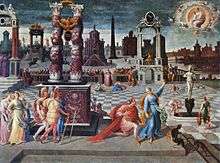Antoine Caron

Antoine Caron (1521–1599) was a French master glassmaker, illustrator, Northern Mannerist painter and a product of the School of Fontainebleau.
He is one of the few French painters of his time who had a pronounced artistic personality.[1] His work reflects the refined, although highly unstable, atmosphere at the court of the House of Valois during the French Wars of Religion of 1560 to 1598.
Life
Caron was born in Beauvais.
He began painting in his teens doing frescos for a number of churches. Between 1540 and 1550 he worked under Primaticcio and Niccolò dell'Abbate at the School of Fontainebleau. In 1561, he was appointed the court painter by Catherine de' Medici and Henry II of France. As court painter he also had the duties of organizing the court pageants. In this way he was involved in organizing the ceremony and royal entry for the coronation of Charles IX in Paris and the wedding of Henry IV of France with Marguerite de Valois. Some of his surviving illustrations are from these pageants.
His drawings of festivities at the court of Charles IX are likely sources for the depiction of the court in the Valois Tapestries. He died in Paris in 1599.
Art

Not many of Caron’s works survive, but they include historical and allegorical subjects, court ceremonies, astrological scenes, and his massacres, done in the mid-1560s. An example is his only signed and dated painting, Massacres under the Triumvirate (1566) which hangs in the Louvre. Caron used bright colors and incorporated unusual architectural forms.[2] He often placed his human figures almost insignificantly on grand stages, as did his mentor dell'Abbate. His figures tend to be elongated, even in portraits such as Portrait of a Lady (1577).
Many works attributed to him are also attributed to others. As there is minimal documentation of French painting in that era, this is not unusual. Because Caron is relatively well known, his name is likely to be attached to paintings similar to his known works.[3] In some cases, such painting are now ascribed "to the workshop of Antoine Caron", for example, The Submission of Milan to Francis I in 1515 (c.1570).[4]
Selected works
- Massacres of the Triumvirate, 1566, oil on linen canvas, 116 x 195 cm, Musée du Louvre, Paris [5][6]
- La Sibylle de Tibur, 1575/1580, oil on canvas, 170 x 125 cm, Louvre, Paris, (The Tiburtine Sibyl or Augustus and the Sibyl of the Tiber)
- Abraham and Melchisedek, c. 1590, wood, 80×94 cm. private collection, Paris
- Astronomers Watching an Eclipse or Dionysius the Areopagite Converting the Pagan Philosophers, 1570s, oil on canvas, 93×73 cm., formerly in the collection of Anthony Blunt, London, now at the J. Paul Getty Museum, Los Angeles
- Portrait of a Lady, 1577, Tempera on panel, Alte Pinakothek, München
- Le train de deuil Amors, Louvre, Paris (The funeral procession of Love or An Allegory of the Death of Love)
- Bagathan and Tharès Staatliche Graphische Sammlung (State Graphics Collection) in the Münchner Haus der Kulturinstitute (Munich Culture Institute), Munich
- The Elephant Carousel, 1598, oil on wood, 87 x 130 cm., private collection, Paris
- The Arrest and Supplication of Sir Thomas More (1478-1535) oil on wood, Musee de Blois, Blois
- Apotheose of Semele, c. 1585, oil on wood, 65×76 cm. private collection, Paris
- The Triumph of Winter, c. 1568, oil on canvas, 103 x 179 cm, private collection
- Diane Chasseresse, 1550, oil on Louvre, Paris, (Diana, the Huntress) [School of Fontainebleau ...][7]
- The Submission of Milan to Francis I in 1515 c. 1570, oil on wood, 50.5 x 66.8 cm, National Gallery of Canada, Ottawa, Ontario [workshop of...][4]
Gallery
-

Augustus and the Sibyl of the Tiber (c.1578)
-

Massacres of the Triumvirate (1566)
-

Portrait of a Lady (1577)
-

Christ and the Adultress
-

Triumph of Winter (c. 1568)
-

Dionysius the Areopagite Converting the Pagan Philosophers (c. 1570)[1]
Notes
- ↑ "Caron, Antoine Web Museum, Paris". Ibiblio.org. 2002-07-14. Retrieved 2013-04-30.
- ↑ Yates, Frances A. (1951) "Antoine Caron's Paintings for Triumphal Arches" Journal of the Warburg and Courtauld Institutes 14(1/2): pp. 132-134
- ↑ "I have already had occasion elsewhere to state my opinion that some of the paintings attributed by M. Ehrmann to Caron may perhaps be by other hands. I still feel it difficult to believe that the Beauvais Massacre with its sharply Flemish architecture can be a product of the French School, and I do not feel convinced that the Semele, the Carrousel with the Elephant, and the Martyrdom of Sir Thomas More are necessarily by his hand. "Blunt, Anthony F. (November 1956) "Review: Antoine Caron Peintre à la Cour des Valois 1521-1599 by Jean Ehrmann" The Burlington Magazine 98(644): p. 418
- 1 2 "Antoine Caron, Workshop of National Gallery of Canada". Cybermuse.beaux-arts.ca. Retrieved 2013-04-30.
- ↑ "Paintings: French Painting: "Massacre under the Triumvirate" Louvre". Louvre.fr. Retrieved 2013-04-30.
- ↑ Porcheron, Marie-Domitille "La mort romaine représentée. Les 'massacres du Triumvirat' par Antoine Caron" In Hinard, François (comp.) (1987) La Mort, les morts et l’au-delà dans le monde romain : actes du colloque de Caen, 20-22 novembre 1985 Centre de publications de l’Université de Caen, Caen, France, pp. 365-370, ISBN 2-905461-22-5
- ↑ "Parcours le corps: Ecole de Fontainebleau: Diane chasseresse" Musée du Louvre Archived September 27, 2007, at the Wayback Machine. in French
References
- Ehrmann, Jean (1955) Antoine Caron: peintre à la cour des Valois, 1521-1599 (Travaux d'humanisme et Renaissance, No 18) Droz, Geneva, OCLC 30014514
- Ehrmann, jean (1986) Antoine Caron: peintre des fêtes et des massacres Flammarion, Paris, ISBN 2-08-010992-8
- Chilvers, Ian (ed.) (2004) "Caron, Antoine (1521-1599)" The Oxford Dictionary of Art (3rd ed.) Oxford University Press, Oxford, ISBN 0-19-860476-9
External links
| Wikimedia Commons has media related to Antoine Caron. |